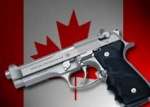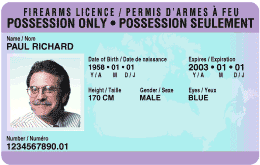Canadian Firearms Program
| Elephantus Blancus Canadianus | |
| Established: | 2008 (CFC in 2003) |
| Minister Responsible: | Peter Van Loan, Minister of Public Safety |
| Agency Executives: |
|
| Annual budget: | 84 million wasted dollars[2] |
| Canadian Gun Law |
|---|

|
|
|
| Regulation |
| Authorization to Carry Authorization to Transport Canadian Firearms Program Long gun registry |
| Licencing |
| Possession and Acquisition Licence (PAL) Possession Only Licence (POL) |
| Timeline |
The Canadian Firearms Program, formerly the Canada Firearms Centre(CAFC) is a Canadian government agency administered by the Royal Canadian Mounted Police Policing Support Services, responsible for licensing and regulating firearms in Canada.
As of December 2008, the Canadian Firearms Program recorded a total of 1,859,501 valid firearm licenses, which is roughly 5.6% of the Canadian population (based on CIA World Factbook July 2008 estimate). The four most licensed provinces are Ontario, Quebec, Alberta and British Columbia.[3]
Contents |
History
Bill C-68: An Act Respecting Firearms and Other Weapons was assented in 1995, two years after the bill was introducted by the government to the House of Commons in targeting firearms licensing and registration. CFC was officially created and began operation in 1996 to oversee the administration of the Firearms Act and the Canadian Firearms Program[4] (including the white elephant of the Canadian gun registry) under the Department of Public Safety.
On May 17, 2006, responsibility for the Canadian Firearms Program was transferred from the Ministry of Public Safety to the RCMP.
On September 4, 2008, the Canada Firearms Centre and the Firearms Support Services Directorate of RCMP was merged to create the Canadian Firearms Program.
CFP celebrated the 10th anniversary of the opening of Central Processing Site in Miramichi, New Brunswick in 2008.[5]
Organization
Under the Constitution of Canada, firearms laws are of federal jurisidiction (See Supreme Court of Canada Reference Case on Firearms Act). Despite this, each province is free to opt-in to operate the program and its regulations - Ontario, Quebec, Prince Edward Island, New Brunswick and Nova Scotia have chose to opt in[6] and British Columbia is contemplating the idea [7]. However, the CFP continues to be the central data-processing site and is responsible for the physical issuance of Possession and Acquisition Licences in all cases.[8] Those who chose to opt-in would have all the administrative fees reimbursed by the federal government per section 95 of the Firearms Act[9].
Federal
CFP is a program within the Royal Canadian Mounted Police. The chain of command is as follow[1]:
The Commissioner of the RCMP serves as the Commissioner of Firearms, the chief executive of the program. The Commissioner is assisted by a Deputy Commissioner (Policing Support Services). They are responsible to the Minister of Public Safety Canada and thus accountable to the Parliament of Canada.
An RCMP officer of Assistant Commissioner rank is appointed as the Director General to oversee the day-to-day administration of the CFP.
A Registrar of Firearms is appointed to issue and revoke firearms registration certificates and carriers’ licences and maintain the records on Canadian Firearms Registry. The Registrar is also responsible for administering the Public Agents Firearms Regulations.
Provincial
Each province has its own Chief Firearms Officer (CFO), appointed by the Executive Council of the province they served in. The three territories shares a CFO with another province (British Columbia - Yukon, Alberta - Northwest Territories & Manitoba - Nunavut). They are responsible for making decisions (grant, deny , revoke or put conditions) on licensing (ie. Possession and Acquisition Licence), Authorization to Transport, Authorization to Carry and transfer of firearms along with all of its administrative work[10].
Each province also appoint firearms officers (generally speaking, police officers) to inspect and ensure compliance within the definition of the Firearms Act. They may apply to court for a preventative prohibition order if it is in the public's interest that a person should not be in possession of any weapons regulated under the Firearms Act.[11] In carrying out their duties, they can demand firearms be presented to them and samples to be taken.[12] Failure to comply is a summary offence which may lead to complications when one is up to renew his/her firearms license for previous contravention of the Firearms Act [13].
Criticism
The CFC has been pummeled by public criticisms since before it even opened. These include, but are by no means limited to, some of the following:
Cost overruns
- Main article: Canadian gun registry
The Canadian long gun registry was meant to cost approximately $119 million and bring $117 million in licencing and other fees, for a net cost of $2 million. It ended up costing over $1 billion dollars to implement. Documents obtained by the Canadian Broadcasting Corporation now estimate the program cost at $2 billion.
In December 2002, the Auditor-General of Canada, Sheila Fraser, reported that the project was running vastly above initial cost estimates. The report shows that the implementation of the firearms registry program by the Department of Justice has had significant strategic and management problems throughout. Taxpayers were originally expected to pay only $2 million of the budget while registration fees would cover the rest. In 1995, the Department of Justice reported to Parliament that the system would cost $119 million to implement, and that the income generated from licensing fees would be $117 million. This gives a net cost of $2 million. At the time of the 2002 audit, the revised estimates from the Department of Justice were that the cost of the program would be more than $1 billion by 2004/05 and that the income from licence fees in the same period would be $140 million.
Corruption charges
- Main article: Farmer Bob varmint gun registry
In January 2006, the RCMP were asked to probe a Liberal Party consultant over a $380,000 contract: Kim Doran was awarded to lobby the federal government for funds for the ailing firearms registry. The five-month contract was awarded by the Justice Department to Doran in March 2003 to lobby the federal Solicitor General, Treasury Board and Privy Council, according to a detailed lobbyist report. At the time, Doran was representing the Coalition for Gun Control. The group, which receives both government and private funding, claims to represent anti-firearm groups and municipalities. It is a strong supporter of the gun registry.
Security
John Hicks, an Orillia-area computer consultant, and webmaster for the Canada Firearms Centre, has said that anyone with a home computer could have easily accessed names, addresses and detailed shopping lists (including make, model and serial number) of registered guns belonging to licensed firearms owners. Hicks told the Ontario Federation of Anglers and Hunters (OFAH) that "During my tenure as the CFC webmaster I duly informed management that the website that interfaced to the firearms registry was flawed. It took some $15 million to develop and I broke it inside of about 30 minutes."
Katey Montague
|
See also
- Canadian gun registry
- Canadian Shooting Sports Association
- Dominion of Canada Rifle Association
- Gun politics in Canada
- National Firearms Association
- Possession and Acquisition Licence
- Authorization to Transport
- Authorization to Carry
Notes
- ↑ 1.0 1.1 Meet Our Team
- ↑ $84 Million for the Canada Firearms Centre
- ↑ Facts and Figures
- ↑ Commissioner of Firearms: 2007 Report
- ↑ 10th anniversary of the Canadian Firearms Program’s Central Processing Site, Miramichi, N.B.
- ↑ The Illegal Movement of Firearms in British Columbia
- ↑ ILLEGAL GUN ACTION PLAN RELEASED
- ↑ Review of the Personal Information Handling Practices of the Canadian Firearms Program
- ↑ Firearms Act S.95
- ↑ Chief Firearms Officers
- ↑ Domestic Violence Handbook: for Police and Crown Prosecutors in Alberta
- ↑ Firearms Act
- ↑ CAFC 921 Question 16(a)(ii)
External links
- Canada Firearms Centre Official website
- Law-abiding Unregistered Firearms Association advocacy group against the Firearms Act / Canada Firearms Centre
- JJHicks.com Security Advisory: Predictability and Vulnerability in the Canadian Firearms Centre's On-Line Services Web Site (www.cfc-ccaf.gc.ca)

This article or section is just a stub, and could use more information to fill in the missing bits.
You (yes, you!) can help Gunsopedia and our users by using your own knowledge to expand it
